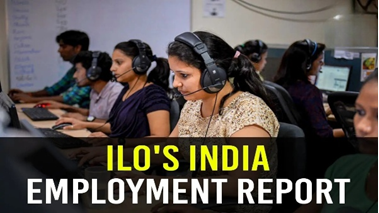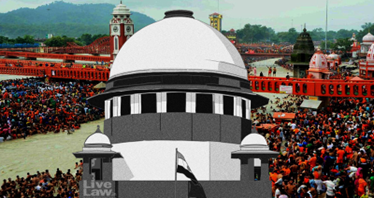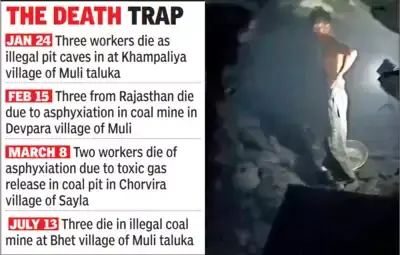Thursday, 1st August 2024
Investors did not pick up Jammu and Kashmir lithium
Why in the news?
- Recently, The Ministry of Mines was forced to scrap the auction for the lithium block in Jammu and Kashmir’s (J&K’s) Reasi district for the second time.
- This comes nearly 18 months after then Mines Secretary Vivek Bharadwaj announced the discovery of an inferred deposit of 5.9 million tonnes of lithium ore, pitched as among the largest deposits in the world.
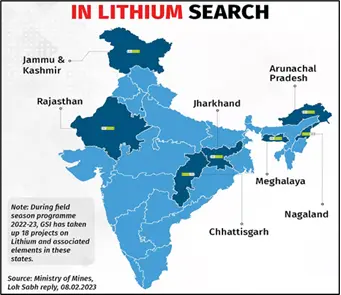
Why Access to or Control over Lithium is Important?
- India’s EV Market Growth:
- India's EV market, valued at $383.5 million in 2021, is expected to soar to $152.21 billion by 2030, emphasising lithium's crucial role in battery production.
- Lithium Battery Imports:
- In 2019-2020, India imported lithium batteries worth $929.26 million (₹6,600 crore), highlighting its dependency on lithium for EVs and energy storage.
- Geopolitical and Economic Impact:
- The global shift to low-carbon economies and advancements in AI and 5G will elevate lithium's strategic value, affecting global geopolitics and market dynamics.
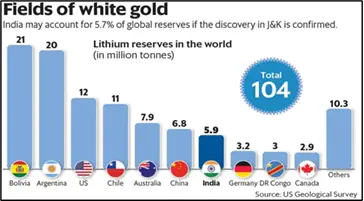
What are the Key Points About the Lithium Block in J&K's Reasi district?
- Estimated Resources:
- Discovery: In February 2023, the Geological Survey of India (GSI) identified 5.9 million tonnes of lithium-inferred resources in Reasi district, Jammu and Kashmir (J&K), crucial for electric vehicle (EV) batteries.
- Global Ranking: This positions India as the seventh-largest source of lithium globally.
- Auction Attempts:
- First Auction: Held in November 2023, but annulled on March 13, 2024, due to fewer than three qualifying bidders.
- Second Auction: Attempted but annulled due to no bidders qualifying.
- Regulatory Framework:
- Auction Rules: According to the Mineral (Auction) Rules, 2015, a second round can proceed with fewer than three bidders, but no bidders met the qualification criteria in this instance.
- Reasons for Investor Hesitation:
- Clay Deposits: The reserves consist primarily of clay deposits, which lack global commercial precedents, complicating the path to commercialization.
- Lack of Beneficiation Study: Absence of a feasibility study for extraction and processing raises concerns about economic viability.
- Sub-Par Reporting Standards: Limited information and inadequate data in auction documents deterred bidders.
- Exploration Stage: The block is at the G3 exploration level (preliminary estimates), contributing to high investment risk and uncertainty.
- Economic Viability: High extraction costs and falling global lithium prices make the project less appealing financially.
- Reserve Price: The reserve price for the second auction, based on the highest previous bid, may have been perceived as too high relative to the block’s value and risks.
What is the Status of Lithium Exploration in India?
- Successful Auction in Chhattisgarh:
- Location: Korba district, Chhattisgarh.
- Outcome: The first successful lithium auction in India took place, with the block awarded to Maiki South Mining Pvt Ltd in June 2024.
- Bid Details: The auction included a premium of 76.05%, indicating strong interest and competitive bidding.
- Additional Findings in Korba:
- Exploration: A private exploration company funded by the National Mineral Exploration Trust (NMET) has identified hard rock lithium deposits in Korba.
- Concentration: Lithium concentrations in these deposits range from 168 to 295 parts per million (ppm).
- Challenges in Other States:
- Manipur: Exploration efforts in Kamjong district have been halted due to local resistance. The NMET committee has decided to pause further activities in this area.
- Ladakh: Exploration in the Merak block, located near the India-China border, has yielded disappointing results. The NMET committee has recommended discontinuing exploration efforts there.
- Assam: Exploration in Dhubri and Kokrajhar districts has not been promising, with the NMET advising against further upgrades or exploration in these regions.
What are the challenges in Extraction and Investment of Lithium in India:
- Extraction Challenges:
- Technological Complexity: Extracting lithium from hard rock pegmatite deposits requires specialised technology and expertise. The process involves multiple complex and costly stages.
- Environmental Concerns: Lithium extraction, particularly through open-pit mining, poses significant environmental risks such as habitat destruction and pollution. Effective management and mitigation are essential.
- Infrastructure Limitations: In remote regions like J&K's Reasi district, inadequate infrastructure for transportation and logistics can impede efficient extraction and increase costs.
- Investment Challenges:
- Nascent Industry: India's lithium sector requires substantial time to establish functional mining and processing infrastructure. The typical timeline from discovery to production for lithium projects is 6 to 7 years.
- Lack of Processing Infrastructure: China controls 65% of the global lithium processing market, while India lacks a foothold in this critical area.
- Limited Domestic Expertise: India's experience in mining and processing lithium is limited, contributing to challenges in accelerating domestic projects.
- Reporting Standards: India's mineral reporting standards (UNFC) do not align with the global Committee for Mineral Reserves International Reporting Standards (CRIRSCO), which affects the assessment of economic viability.
- Local Tensions: Ethnic and religious tensions can complicate efforts to attract investment and manage resource development.
- Global Competition: China controls 77% of the global lithium-ion battery manufacturing capacity, creating strategic challenges for India, which seeks to reduce dependency on Chinese supplies.
Way Forward:
- Attract Foreign Expertise:
- Engage Global Players: Attract foreign companies with experience in lithium mining and processing to accelerate domestic exploration and development.
- Learn from the Lithium Triangle:
- Adopt Best Practices: Bolivia, Chile, and Argentina offer valuable lessons in state-controlled or regulated lithium extraction processes.
- Integrate Sustainability:
- Lifecycle Management: Incorporate sustainability principles throughout the entire lifecycle of lithium mining, from extraction to battery disposal.
- Local Involvement:
- Community Engagement: Involve local communities in exploration plans and prioritise them for employment opportunities, while addressing broader socio-economic impacts.
- Government Incentives:
- Policy Support: Utilise government initiatives like Production-Linked Incentive (PLI) schemes to improve the business environment and attract investments from major players.
- Further Exploration:
- Resource Clarity: Continue exploration to provide clearer resource estimates, making the block more attractive to investors, though this requires additional time and investment.
- Government-Initiated Development:
- Direct Involvement: Consider government-led prospecting or mining operations through a government-owned company, as permitted under the Mines and Minerals (Development and Regulation) (MMDR) Act.
- Ease Business Conditions:
- Regulatory Reforms: Amend mining regulations to enhance ease of doing business and negotiate trade agreements to ensure fair market access and protect India’s interests in the lithium supply chain.
|
UPSC Civil Services Examination, Previous Year Question (PYQ) Prelims Q:1 Which one of the following pairs of metals constitutes the lightest metal and the heaviest metal, respectively? (2008)
Ans: (b)
Mains Q:1 Despite India being one of the countries of Gondwanaland, its mining industry contributes much less to its Gross Domestic Product (GDP) in percentage. Discuss. (2021) |
Source: IE
A Licence Raj for Digital Content Creators
E-Governance– Digital Rights and Policies
Why in the news?
- Recently, the Indian government is introducing new regulations aimed at controlling digital content creators through the Broadcasting Regulation Bill, 2024.
- The advent of digital media has transformed India's political landscape, as highlighted by CSDS-Lokniti surveys covering 642 million voters and 924 million broadband connections.
- Digital platforms are increasingly shaping public opinion and political discourse, particularly among younger, tech-savvy voters, despite the continued dominance of television.
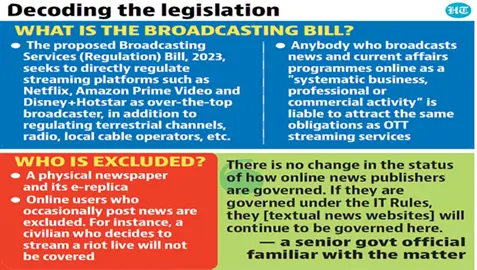
Digital Media Consumption Patterns:
- Daily Engagement: 29% of respondents access political content on digital platforms daily; an additional 18% do so occasionally.
- Platform Preferences: Digital platforms like WhatsApp (35.1%), YouTube (32.3%), Facebook (24.7%), Instagram (18.4%), and Twitter (6.5%) surpass traditional newspapers (16.7%) and radio (6.9%) for daily political content consumption.
- Shift in Influence: This trend indicates a shift towards content-driven and influencer-based political engagement.
Analysis of Digital Media’s Political Influence:
- Emergence as a Political Force: Digital media offers real-time engagement, surpassing traditional media in its ability to shape political opinions and activism.
- Democratisation of Information: Platforms enable access to diverse perspectives, diminishing the traditional gatekeeping role of mainstream media.
- Enhanced Political Participation: Digital platforms facilitate political activities and direct engagement with voters, enhancing democratic participation.
- Influencer and Content-Driven Politics: Influencers on platforms like YouTube and Instagram significantly impact public opinion and political discourse.
- Rapid Spread of Information and Misinformation: The speed of information dissemination on digital platforms poses risks of misinformation, highlighting the need for robust fact-checking and digital literacy.
Case Studies of Political Influence:
- 2016 US Presidential Election:
- Social media: Platforms like Facebook and Twitter were crucial for targeted campaigning.
- Issues: Spread of misinformation and foreign interference highlighted the vulnerabilities of digital platforms.
- 2014 and 2019 Indian General Elections:
- BJP’s Strategy: The BJP used WhatsApp, Facebook, and Twitter to engage young and first-time voters.
- Outcome: This digital strategy significantly contributed to the party's electoral victories.
Governmental Control and Regulatory Measures:
- IT Rules, 2021:
- Initial Framework: Expanded the Ministry of Electronics and Information Technology (MeitY) and granted the Ministry of Information and Broadcasting (MIB) new authorities over digital news media and online entertainment streaming apps.
- Challenges: The Union Government faced difficulties in fully controlling digital content, necessitating further regulatory measures.
- Grievance Appellate Committees (GACs) - 2023:
- Creation: Established three GACs to handle appeals and issue content-related orders, involving officials from MeitY, MIB, and the Ministry of Home Affairs (MHA).
- Amendment of 2023:
- Content Removal: Granted the government the power to remove digital content deemed fake, false, or misleading. However, this amendment was stayed by the Supreme Court of India on March 21, 2024.
Key Highlights of the Broadcasting Services (Regulation) Bill, 2024:
- Purpose: Introduced to address limitations of the IT Rules, 2021, aiming to enhance control over digital media.
- Key Provisions:
- Registration Requirement: Digital creators commenting on politics or news must register and operate under MIB’s oversight.
- Classification: Individual commentators classified as Digital News Broadcasters and content creators as OTT Broadcasters, with registration required once specific user thresholds are met.
- New Compliances: Imposes new obligations on online platforms and establishes a safe harbour regime independent of the Information Technology Act, 2000.
- Censorship Mechanisms: Aims to enforce censorship through proactive compliances, registrations, and fines, potentially relying on vague provisions that could lead to arbitrary enforcement.
Implications for Democratic Expression:
- Shift Towards Digital Authoritarianism: The Broadcasting Bill, 2024 represents a move towards greater government control over digital narratives, reflecting a bureaucratic approach that could stifle democratic expression.
- Threat to Freedom: The bill's enforcement may curtail the freedoms of digital creators and limit the diversity of political discourse in India, raising concerns about its impact on democratic engagement and transparency.
Conclusion:
The rise of digital media emphasises the need for balanced regulation that safeguards democratic freedoms while ensuring responsible use of digital platforms. The Union Government's regulatory measures must navigate these objectives to avoid stifling the democratic potential of digital media.
|
UPSC Civil services Examination, PYQ Mains: Q1 Has digital illiteracy, particularly in rural areas, coupled with lack of Information and Communication Technology (ICT) accessibility hindered socio-economic development? Examine with justification. (2021) Q2 What do you understand about the concept “freedom of speech and expression”? Does it cover hate speech also? Why do films in India stand on a slightly different plane from other forms of expression? Discuss. (2014) |
Source: TH
SEBI’s proposed measures to curb F&O speculation
Why in the News?
- Recently, the Securities and Exchange Board of India (SEBI) has proposed a series of short-term measures to curb speculative trading in index derivatives (futures and options).

About Futures & Options:
- Definition: Futures and options are derivative financial contracts whose value is derived from the performance of an underlying asset, such as stocks, commodities, currencies, or indexes.
- Applications: They are utilised for hedging risks, speculating on price movements, and leveraging positions in financial markets.
Futures Trading:
- Definition: A futures contract is a standardised agreement to buy or sell a specified quantity of an asset at a predetermined price on a specified future date.
- Key Features:
- Standardisation: Futures contracts are standardised regarding quantity, quality, and delivery date.
- Leverage: Traders can control large positions with a relatively small amount of capital, known as margin.
- Obligation: Both the buyer and the seller must fulfill the contract terms at expiration unless the position is closed before the expiry date.
- Applications:
- Hedging: Used by producers and consumers to lock in prices and hedge against price fluctuations (e.g., a wheat farmer selling wheat futures).
- Speculation: Traders speculate on price movements to profit from market volatility (e.g., buying crude oil futures anticipating a price increase).
Options Trading:
- Definition: An options contract grants the holder the right, but not the obligation, to buy (call option) or sell (put option) an underlying asset at a specified price (strike price) before or on a specified date.
- Key Features:
- Right, Not Obligation: Provides flexibility as the holder can choose whether or not to execute the contract.
- Premium: The buyer pays a premium to the seller for this right.
- Leverage: Allows significant exposure with a relatively small investment.
- Types:
- Call Option: Right to buy the underlying asset at the strike price.
- Put Option: Right to sell the underlying asset at the strike price.
- Applications:
- Hedging: Protects against adverse price movements in a portfolio (e.g., purchasing put options to hedge against a decline in stock prices).
- Speculation: Traders bet on market direction (e.g., buying call options if expecting a price rise).
Differences Between Futures and Options:
- Obligation: Futures contracts require execution, while options provide the right without obligation.
- Risk and Reward: Futures involve higher risk with unlimited gains and losses. Options limit the buyer’s loss to the premium paid, with substantial potential gains.
- Flexibility: Options offer more flexibility with the right to execute the contract, whereas futures require execution unless closed early.
Short-Term Measures to Curb Speculative Trading:
- Proposals by SEBI:
- Restricting multiple option contract expirations.
- Raising the size of options contracts.
- Implementing intraday monitoring of position limits.
- Context: These measures follow the proposal to double the Securities Transaction Tax (STT) on futures and options from October 1, 2024, to address the surge in trading volume.
- Need for Measures:
- Statistics: 92.50 lakh unique individuals and firms traded in index derivatives in 2023-24, with a cumulative loss of ₹51,689 crore. 85% of traders experienced net losses.
- Recommendations: Increase minimum contract size in phases, rationalise options strikes, collect option premiums upfront, and eliminate margin benefits for same day expiring contracts.
- Objective: Enhance investor protection and ensure market stability.
Source: IE
9th Governing Council Meeting of NITI Aayog
Why in the news?
- Recently, the 9th Governing Council Meeting of NITI Aayog, chaired by the Prime Minister, recently convened leaders from 20 states and 6 union territories.
- The focus was on the theme "Viksit Bharat @2047," aiming to establish a strategic framework for India’s development into a developed nation by 2047.

Key Outcomes of the Meeting:
- Vision of a USD 30 Trillion Economy
- Objective: India aims to become the world’s third-largest economy by 2047 with a GDP target of USD 30 trillion.
- Significance: Highlights the country’s commitment to sustained economic growth, innovation, and global competitiveness.
- State Visions for 2047
- Encouragement: States and districts were urged to formulate their visions aligned with the national goal of a developed India.
- Emphasis: Developed states are crucial for national development.
- Zero Poverty Objective
- Focus: Emphasis on eradicating poverty at an individual level through 'zero poverty' villages.
- Goal: Holistic development starting from the grassroots.
- Infrastructure and Investment
- Importance: Stress on infrastructure, law and order, and good governance to attract investments.
- Proposal: Introduction of an 'Investment-friendly Charter' to foster a competitive investment environment among states.
- Education and Skill Development
- Objective: Strengthening youth skills to enhance employment readiness.
- Strategy: Positioning India as a global hub for skilled resources.
- Agricultural Productivity and Natural Farming
- Discussion Points: Improving agricultural productivity, diversifying agriculture, and promoting natural farming practices.
- Benefits: Enhancing soil fertility, reducing costs, and accessing global markets.
- Ease of Living
- Recommendations: Consideration of key themes from the 3rd National Conference of Chief Secretaries, including drinking water, electricity, health, schooling, and land/property management.
- Demographic Management Plans
- Action: Development of plans to address population ageing issues.
- Capacity Building: Encouragement for states to enhance the capacity of government officials through collaboration with the Capacity Building Commission.
- River Grids Creation
- Advocacy: Creation of River Grids at the state level for effective water resource utilisation.
- Cybersecurity and AI in Governance
- Focus Areas: Integration of technology in governance, addressing cybersecurity challenges, and leveraging AI for efficient administration.
Note:
- Under the overarching theme of ‘Ease of Living’, recommendations were made during the 3rd National Conference of Chief Secretaries on the following five key themes:
- Drinking Water: Access, Quantity, and Quality
- Electricity: Quality, Efficiency, and Reliability
- Health: Accessibility, Affordability, and Quality of Care
- Schooling: Access and Quality
- Land and Property: Accessibility, Digitization, Registration, and Mutation
Governing Council of NITI Aayog:
- About
- The Governing Council is the principal body responsible for developing a shared vision of national priorities and strategies through active participation of States.
- It aims to shape the development narrative by fostering cooperative federalism.
- The Council provides a platform to address inter-sectoral, inter-departmental, and federal issues to expedite the implementation of the national development agenda.
- Members
- Chairperson: Prime Minister of India
- Chief Ministers: From States and Union Territories with legislatures
- Lieutenant Governors: From Union Territories without legislatures
- Ex-Officio Members:
- Vice Chairman, NITI Aayog
- Full-Time Members, NITI Aayog
- Special Invitees: As needed
- Functions:
- Coordination: The Governing Council Secretariat (GCS) manages the meetings of the Governing Council and coordinates activities across all Verticals, Divisions, and Units of NITI Aayog.
- Annual Report: GCS acts as the nodal division for coordinating matters related to NITI Aayog's Annual Report for circulation in Parliament.
- Parliamentary Affairs: Handles Parliament Questions, Standing Committee matters, RTI queries, and CPGRAMS grievances related to GCS.
|
UPSC Civil Services Examination, Previous Year Question (PYQ) Prelims: Q:1 Atal Innovation Mission is set up under the (2019) (a) Department of Science and Technology (b) Ministry of Labour and Employment (c) NITI Aayog (d) Ministry of Skill Development and Entrepreneurship
Ans: (c)
Q:2 The Government of India has established NITI Aayog to replace the (2015)
Ans: (d)
Mains: Q:1 Mention core strategies for the transformation of aspirational districts in India & explain the nature of convergence, collaboration & competition for its success. (2018) |
Source: PIB
Need Strengthening Suicide Prevention Efforts in India
Why in the news?
- Recently, an article in The Lancet emphasized the urgent need for enhanced political commitment to address suicide prevention in India, where over 100,000 lives are lost annually.
- It also reviewed the National Suicide Prevention Strategy (NSPS) introduced in 2022, noting the limited progress since its launch.
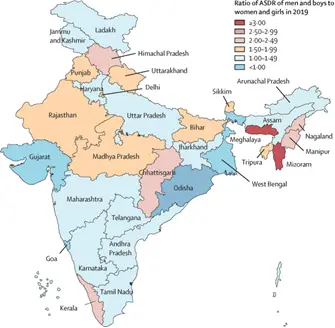
What is the National Suicide Prevention Strategy?
- About:
- The National Strategy for Suicide Preventin in India aims to reduce suicide mortality by 10% by 2030 through a collaborative approach involving multiple sectors.
- The strategy provides a framework for stakeholders to implement, monitor, and adjust actions to meet its objectives.
- Vision: Create a society where people value their lives and receive necessary support during critical periods.
- Objectives:
- Establish psychiatric outpatient departments in all districts within five years via District Mental Health Programmes.
- Integrate mental well-being curricula into educational institutions within eight years.
- Develop guidelines for responsible media reporting and limit access to means of suicide.
What is the Suicide Scenario in India?
- Annual Deaths: In 2022, India reported over 170,000 suicides, with daily wage earners, agricultural laborers, and farmers being the most affected. The suicide rate rose from 10.2 to 11.3 per 100,000 from 2019 to 2022.
- Primary Affected Groups:
- 9.6% were self-employed or salaried professionals.
- 9.2% were unemployed.
- Over 12,000 students died by suicide.
- Among 48,000 women who died by suicide, 52% were homemakers.
- Geographical Distribution: Maharashtra had the highest number of suicides (22,746), followed by Tamil Nadu (19,834), Madhya Pradesh (15,386), Karnataka (13,606), Kerala (10,162), and Telangana (9,980).
- Causes: Major causes included family issues, unemployment, financial problems, illness, drug abuse, and marriage-related issues. Notably, young women face increased pressures from educational expectations, societal norms, and gender discrimination.
What is the Need to Address Suicide Prevention in India?
- Impact on Individuals and Society: Each suicide significantly affects family and friends, highlighting extensive social and emotional consequences.
- Mental Health Stigma: Cultural stigma often prevents individuals from discussing mental health issues or seeking help. Suicide is frequently misinterpreted as a moral failing rather than a sign of psychological distress.
- Economic Burden: Suicides incur healthcare costs and productivity losses, impacting the national economy.
What are the Challenges Related to Suicide Prevention in India?
- Lack of Resources: India's healthcare system struggles with inadequate mental health resources, a shortage of professionals, and limited access to affordable care, particularly in rural areas.
- Insufficient Data Collection: Inadequate reporting and lack of comprehensive studies hinder understanding the crisis and formulating effective interventions.
- Lack of Political Will: Both central and state governments show insufficient commitment to suicide prevention. Despite policies like the Mental Healthcare Act, 2017 and NSPS, gaps in implementation persist.
- Inadequate Media Involvement: The media often lacks proper guidelines for reporting suicides responsibly, impacting public perception and awareness.
What are the Initiatives Related to Suicide Prevention in India?
- National Mental Health Programme (NMHP): Implements the District Mental Health Programme (DMHP) in 738 districts, providing outpatient services, counselling, and inpatient care.
- National Tele Mental Health Programme: Launched in 2022 to enhance access to mental health services nationwide. As of December 2023, 34 States/UTs have 46 Tele MANAS Cells handling over 500,000 calls.
- KIRAN Helpline: A 24/7 toll-free helpline launched by the Ministry of Social Justice and Empowerment for mental health support.
- Ayushman Arogya Mandirs: Over 160,000 health centers have been upgraded to include mental health services in the Comprehensive Primary Health Care package.
- Manodarpan Initiative: Launched under Atmanirbhar Bharat Abhiyan to provide psychosocial support during Covid-19.
Way Forward:
- Workplace Wellness
- Mandate Mental Health Support: Ensure mental health resources are available in workplaces, particularly in high-stress industries.
- Public Health Strategies: Implement gatekeeper training and awareness programs to enhance early detection and intervention.
- Strengthen Mental Health Infrastructure
- Expand Access: Increase the availability of mental health services, especially in rural and underserved areas.
- Increase Professionals: Raise the number of trained mental health professionals to meet demand.
- Targeted Interventions: Develop specific support systems for high-risk groups, including farmers, students, women, and the elderly.
- Impact of Reduction: A 20% reduction in suicides could save approximately 40,000 lives annually.
- Addressing Root Causes
- Economic and Social Measures: Create jobs, reduce inequality and poverty, and strengthen social safety nets.
- Promote Equality: Advance gender equality, tackle domestic violence, and address dowry-related harassment.
- Guidelines and Awareness: Enforce guidelines to prevent copycat suicides and increase mental health awareness.
- Implement Comprehensive Education Programs
- Mental Health Education: Introduce broad mental health education programs to foster open dialogue and promote stress management techniques.
- Technology and Mental Health
- Expand Digital Services: Utilise digital platforms to increase access to mental health services.
- Peer Support: Facilitate online communities for peer support.
- Self-Care Apps: Develop user-friendly applications for self-care and stress management.
- Data Utilisation: Leverage data to identify patterns and target interventions more effectively.
|
UPSC Civil Services Examination, Previous Year Question: Mains Q:1 Why suicide among young women is increasing in Indian society? (2023) |
Achanakmar Tiger Reserve
Why in the news?
- The Achanakmar Tiger Reserve in Chhattisgarh has observed a notable rise in its tiger population, increasing from 5 to 10 as per the All-India Tiger Estimation (AITE) 2022 census.


About Achanakmar Tiger Reserve:
- Location:
- Situated in the Bilaspur district of Chhattisgarh.
- Established as Achanakmar Wildlife Sanctuary in 1975.
- Declared a tiger reserve in 2009.
- Covers an area of 553.286 sq. km.
- Part of the expansive Achanakmar-Amarkantak Biosphere Reserve.
- Corridor:
- Features a critical corridor connecting Kanha and Bandhavgarh Tiger Reserves.
- Plays a vital role in the dispersal of tigers among these reserves.
- River:
- The Maniyari River flows through the center of the reserve, serving as the forest's lifeline.
- Tribal Communities:
- Home to the Baigas, a forest-dwelling tribal community classified as a “Particularly Vulnerable Tribal Group (PVTG).”
- Within 626 hectares of the core area, there are 25 forest villages.
- Approximately 75 percent of the population belongs to the Baiga tribe.
- The remaining population consists of Gond and Yadav communities.
- Vegetation:
- Predominantly covered by tropical moist deciduous vegetation.
- Flora:
- Includes Sal, bija, saja, haldu, teak, tinsa, dhawara, lendia, khamar, and bamboo.
- Over 600 species of medicinal plants are found here.
- Fauna:
- The reserve's fauna includes tigers, leopards, bison, flying squirrels, Indian giant squirrels, chinkaras, wild dogs, hyenas, sambars, chitals.
- Over 150 species of birds are present.
|
UPSC Civil Services Examination, Previous Year Question (PYQ) Prelims Q1. Consider the following protected areas: (2012)
Which of the above are declared Tiger Reserves?
Ans: (b)
Q2. From the ecological point of view, which one of the following assumes importance in being a good link between the Eastern Ghats and the Western Ghats? (2017)
Ans: (a) |
Source: TOI
Zika virus
Why in the news?
- Recently, the Union Minister of State for Health and Family Welfare Anupriya Patel, said the government of India has formulated an action plan for managing Zika virus Disease.
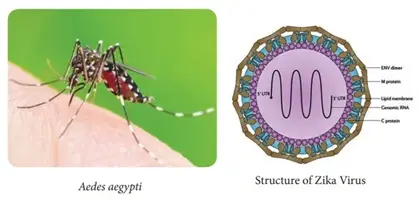
What is the Zika virus?
- Discovery:
- The Zika virus, a mosquito-borne pathogen, was first identified in a Rhesus macaque in Uganda's Zika Forest in 1947.
- Human cases were confirmed in the 1950s across various African nations.
- Impact:
- Although Zika fever is typically mild, the virus poses significant risks to pregnant women, leading to microcephaly in newborns and Guillain-Barré syndrome, a rare nerve disorder causing muscle weakness and paralysis.
About Zika Virus:
- Classification:
- Zika virus belongs to the Flavivirus genus in the Flaviviridae family.
- Transmission:
- Predominantly spread by Aedes mosquitoes (Aedes aegypti and Aedes albopictus), which also transmit dengue and yellow fever.
- Other transmission modes include sexual contact, blood transfusion, organ transplantation, and congenital infection.
- Significant Outbreaks:
- Major epidemic in Brazil (2015), WHO declared it a Public Health Emergency of International Concern in 2016.
- Cases detected in India in Gujarat, Madhya Pradesh, Rajasthan (2018), and Kerala, Maharashtra (2021).
Structure:
- Genetic Makeup: Single-stranded RNA virus with two main lineages—African and Asian.
- Proteins: Encodes three structural proteins (capsid, membrane, envelope) and seven nonstructural proteins aiding in replication and host manipulation.
- Research Milestone: Near-atomic structure revealed through cryo-electron microscopy.
Symptoms:
- Incubation Period: 3 to 12 days post-mosquito bite.
- Common Symptoms: Maculopapular rash, arthralgia, fatigue, conjunctivitis, myalgia, headache.
- Rash Spread: Typically begins on the face, spreading across the body.
- Less Common Symptoms: Retro-orbital pain, gastrointestinal issues.
- Asymptomatic Cases: Approximately 80% of infections show no symptoms.
Testing:
- Diagnostics: Primarily relies on detecting viral RNA in clinical specimens (blood, saliva, urine, etc.).
Treatment:
- Current Status: No vaccine or specific antiviral treatment available.
- Symptomatic Relief: Focuses on hydration, pain relief, and antihistamines for rashes.
- Control Measures: Regular vector surveillance and integrated management of Aedes mosquitoes (environmental modification, personal protection, biological and chemical controls).
Challenges in India:
- Knowledge Gaps: Limited understanding of the virus's epidemiological properties and interactions with other arboviruses.
- Laboratory Capacity: Issues with cross-reactivity in diagnostic flavivirus antibody assays.
- Herd Immunity: Lack of immunity in newly affected areas.
- Population Mobility: High mobility and cross-border movement complicate control efforts.
- Healthcare System: Underfunding and inadequate facilities hinder effective epidemic response.
- Favourable Conditions: Breeding conditions for Aedes mosquitoes, inadequate vector surveillance systems.
Current Situation:
- Recent Developments: As of the 2022 All-India Tiger Estimation, the tiger count in Achanakmar Tiger Reserve increased significantly, reflecting improved conservation efforts.
Conclusion
The Zika virus, despite being a mild infection for most, poses serious health risks, particularly to pregnant women and their foetuses. Ongoing research, effective vector management, and improved healthcare infrastructure are essential to combat its spread and impact.
|
UPSC Civil Services Examination, Previous Year Question: Prelims Q:1 Consider the following statements: (2017)
Which of the statements given above is/are correct?
Ans: (c) |
Source: NDTV
Nano-MIND Technology
Why in the news?
- Recently, Researchers from the Korean Institute of Basic Science have developed a magnetogenetics technology named Nano Magnetogenetic Interface for NeuroDynamics (Nano-MIND) which has been demonstrated on mice.
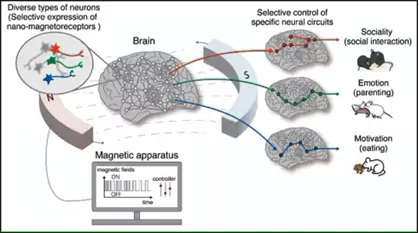
|
Recent Development:
|
About Nano-MIND Technology:
- Definition: Nano-MIND stands for Nano Magnetogenetic Interface for NeuroDynamics, opening new avenues for understanding and manipulating complex brain functions such as cognition, emotion, and motivation.
- Mechanism: Utilises wireless, remote, and precise modulation of specific deep brain neural circuits using magnetic fields and magnetic nanoparticles.
- Advancement: Represents a significant improvement over existing brain manipulation methods by selectively activating targeted brain circuits.
Research Highlights:
- Neural Activation:
- Demonstrated by activating specific neurons in different brain regions of mice.
- Maternal Behaviour:
- Successfully activated inhibitory GABA receptors in the medial preoptic area (MPOA), responsible for maternal behaviours.
- Non-maternal female mice exhibited increased nurturing behaviours when these neurons were stimulated.
- Feeding Behaviours:
- Successfully regulated feeding behaviours by targeting motivation circuits in the lateral hypothalamus.
- Activation of inhibitory neurons led to a 100% increase in appetite and feeding behaviours.
- While activation of excitatory neurons resulted in over a 50% reduction in appetite and feeding behaviours.
Significance:
- Neuroscience Research: Represents a significant step forward in neuroscience research, offering new insights into brain functions.
- Potential Applications: Could have far-reaching implications for the development of Brain-Computer Interfaces (BCIs) and the treatment of neurological disorders
Source: IT
PARAKH
Why in the news?
- Recently, PARAKH submitted a report to the Education Ministry recommending the inclusion of student performance from Classes 9, 10, and 11 into the final Class 12 marks.
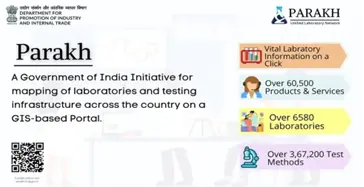
What is PARAKH?
- About:
- Launch Context: PARAKH was launched as part of the implementation of the National Education Policy (NEP) 2020, which envisaged a standard-setting body to advise school boards on new assessment patterns, latest research, and promote collaborations between them.
- Constituent Unit: It will act as a constituent unit of the NCERT.
- Assessment Tasks: PARAKH will be responsible for holding periodic learning outcome tests like the National Achievement Survey (NAS) and State Achievement Surveys.
- Major Assessment Areas: It will work on three major assessment areas: large-scale assessments, school-based assessments, and examination reforms.
- Objective:
- Uniform Norms & Guidelines: Setting norms, standards, and guidelines for student assessment and evaluation for all recognized school boards in India.
- Enhance Assessment Pattern: Encourage and assist school boards in shifting their assessment patterns towards meeting the skill requirements of the 21st century.
- Reduce Disparity in Evaluation: Bring uniformity across state and central boards, which currently follow different standards of evaluation, leading to wide disparities in scores.
- Benchmark Assessment: Develop a benchmark assessment framework to reduce the emphasis on rote learning, as envisaged by NEP 2020.
- Significance:
- Removes Disparity in College Admission: It will help address the issue of students from some state boards being at a disadvantage during college admissions compared to their peers in CBSE schools.
- Innovative Evaluation: Develop and implement technical standards for the design, conduct, analysis, and reporting of tests at all levels of school education.
- Holistic Approach: Facilitate an inclusive, participatory, and holistic approach to education, considering field experiences, empirical research, stakeholder feedback, and lessons learned from best practices.
- Major Areas of Focus:
- Capacity Development in Competency-Based Assessment
- Large-Scale Achievement Survey
- Equivalence of School Boards
- Holistic Progress Cards: For the Foundational, Preparatory, Middle, and Secondary Stages
|
UPSC Civil Services Examination Previous Year Question (PYQ) Mains Q:1 Education is not an injunction; it is an effective and pervasive tool for all-round development of an individual and social transformation”. Examine the New Education Policy, 2020 (NEP, 2020) in light of the above statement. (2020) |
Source: BS
Demographic dividend: India's Elderly at the Crossroad
Context:
- India is undergoing a rapid demographic shift with an ageing population, set to rise from 8.6% in 2011 to 20.8% by 2050.
- This swift ageing contrasts with the slower pace in Western countries and is outstripping the development of social protection systems.
- Unlike some East and Southeast Asian nations, India lacks a universal pension scheme, comprehensive health insurance, and robust social care for the elderly.
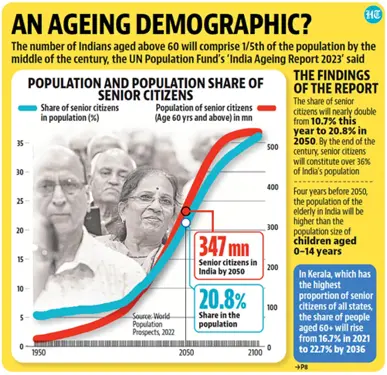
- Current data reveal significant inequalities in service availability, accessibility, and affordability, influenced by factors such as location, class, caste, gender, and formal employment access.
- Addressing these disparities in financial security, health services, and social care is crucial as India becomes an ageing society.
What are the major challenges faced by the elderly in India?
- The Pension Predicament:
- India's pension system is inadequate, with only about 12% of the workforce covered by formal schemes (World Bank).
- Most elderly individuals lack financial security in old age.
- The National Social Assistance Programme (NSAP) provides a minimal pension of Rs. 200-500 per month, insufficient for basic needs.
- Healthcare Hurdles:
- Non-communicable diseases (NCDs) such as diabetes, hypertension, and cardiovascular conditions heavily affect the elderly.
- The Longitudinal Ageing Survey in India (LASI) reports widespread NCDs among those over 60.
- High healthcare costs are impoverishing 55 million Indians annually, with the elderly particularly vulnerable.
- India has a shortage of geriatric care facilities and specialists, producing only 20 geriatricians per year.
- The Loneliness Epidemic:
- Urbanisation and changing family structures have led to social isolation among the elderly, replacing traditional joint family systems with nuclear families.
- This isolation has mental health repercussions, with depression rates among the elderly estimated at 10-20%.
- The Covid-19 pandemic exacerbated these issues, underscoring the need for community support and social engagement.
- Left Behind in a Tech-Driven World:
- Rapid digitization leaves many elderly citizens digitally illiterate, with about 86% lacking the skills to use digital technology or computers.
- This digital divide limits their access to essential services and social connections, deepening their isolation and dependency.
- Elder Abuse:
- Elder abuse is increasing, with a 251% rise in reported cases post-lockdown according to Elders Helpline 1090 and Elderline 14567.
- Financial exploitation, neglect, and physical abuse are common.
- Despite the Maintenance and Welfare of Parents and Senior Citizens Act, 2007, enforcement is weak, and many cases go unreported due to dependency, fear, or stigma.
- Housing Havoc:
- Adequate and affordable housing for the elderly is scarce. While retirement communities exist for the affluent, options for middle and lower-income seniors are limited.
- Existing housing lacks age-appropriate design features, such as ramps and grab bars, posing safety risks.
- The shortage of affordable assisted living facilities adds to the challenge.
What are the major elderly care schemes in India?
- Department of Social Justice and Empowerment:
- Atal Vayo Abhyudaya Yojana: Umbrella scheme for elderly welfare.
- Integrated Programme for Senior Citizens (IPSrC): Establishes homes providing shelter, food, medical care, and entertainment.
- State Action Plan for Senior Citizens (SAPSrC): Encourages states/UTs to develop their own senior citizen welfare plans.
- Rashtriya Vayoshri Yojana (RVY): Provides physical aids and assisted-living devices.
- Livelihood and Skilling Initiatives: Includes Senior Able Citizens for Re-Employment in Dignity (SACRED) and Action Groups Aimed at Social Reconstruction (AGRASR).
- Awareness Generation and Capacity Building: Includes training, sensitization, and National Helpline for Senior Citizens (Elderline: 14567).
- Ministry of Rural Development:
- National Social Assistance Programme (NSAP): Financial assistance for elderly, widows, and disabled persons.
- Indira Gandhi National Old Age Pension Scheme (IGNOAPS): Monthly pension for elderly BPL individuals.
- Ministry of Health and Family Welfare:
- National Programme for the Health Care of Elderly (NPHCE): Provides comprehensive healthcare at primary, secondary, and tertiary levels.
- Primary & Secondary Care: Includes geriatric OPD, IPD, physiotherapy, and lab services in 713 districts.
- Tertiary Care: Includes Regional Geriatric Centres (RGCs) and 2 National Centres for Ageing.
- Ministry of Finance:
- Atal Pension Yojana (APY): Pension scheme for individuals aged 18-40, guaranteeing a pension at age 60.
- Ministry of Housing and Urban Affairs:
- Model Building Bye Laws, 2016: Standards for elder-friendly building environments.
- Urban Bus Specification-II (2013): Promotes low floor buses for easier access for the elderly and disabled.
- Pradhan Mantri Awas Yojana: Prioritises housing allocation for families with senior citizens on ground or lower floors.
- DAY-NULM: Provides shelters for urban homeless, including seniors.
What additional measures to enhance elderly care in India?
- Silver Economy Boost:
- "Silver Skills" Program: Implement a national program to retrain and employ seniors in sectors such as childcare, traditional crafts, and mentorship roles.
- Tax Incentives and Microfinance: Create tax incentives for companies hiring workers over 60 and establish a government-backed microfinance scheme for elderly entrepreneurs.
- Example: Adapt Singapore’s "WorkPro" scheme, which provides grants to age-friendly companies, to India for generating income and utilising elderly experience.
- Tech-Empowered Eldercare:
- "Digital Dada-Dadi" Initiative: Launch a nationwide program to enhance digital literacy among the elderly, ensuring measures for digital penetration reach the last mile.
- Tech Partnerships and Subsidies: Collaborate with tech companies to develop user-friendly apps for health monitoring, social connectivity, and essential services, and implement a subsidised smartphone program for low-income seniors.
- "Digital Sahayaks": Establish a network of young volunteers to provide tech support to seniors in their communities.
- Community Care Hubs:
- "Varishtha Seva Kendras": Create senior service centres in every urban ward and rural panchayat as one-stop shops for health check-ups, legal aid, pension services, and social activities.
- Model: Adapt Japan’s community-based integrated care system, including home care coordination and respite care for caregivers, with local NGOs managing the centres.
- Geriatric Health Corps:
- "Geriatric Health Workers": Form a cadre of geriatric health workers within the ASHA framework, providing specialised training and digital health toolkits for remote monitoring and assessments.
- Mobile Clinics and Education: Establish mobile geriatric clinics for remote areas and integrate geriatric care modules into medical and nursing curricula. Leverage initiatives like IISc Bengaluru's 'Longevity India' for research and interventions.
- Improving Financial Security Net:
- "Senior Citizen Savings Bond": Introduce bonds with higher interest rates for old age financial planning.
- Specialized Health Insurance:
- Develop health insurance products with lower premiums and broader coverage, including mental health and home care services.
- Adapt models like Japan’s Long-Term Care Insurance to the Indian context.
- Elder Rights Protection:
- Elder Protection Units: Establish units in police stations to handle elder abuse and exploitation cases.
- Mandatory Reporting System: Implement systems for healthcare providers and bank officials to report suspected elder abuse.
- Legislation Enforcement: Strengthen the Maintenance and Welfare of Parents and Senior Citizens Act by setting up fast-track courts for elder-related cases and increasing penalties for non-compliance.
- Age-Friendly Cities:
- "Age-Friendly City" Certification: Develop a certification program with guidelines for accessible public spaces, transportation, and services.
- Incentives:
- Provide funding and recognition to cities implementing these guidelines.
- Features could include accessible public toilets, priority seating in public transport, and elderly-friendly parks.
- Elderly Nutrition Mission:
- "Poshan for Elders" Scheme: Extend child nutrition principles to the elderly, including fortified meals from community kitchens, nutrition education for caregivers, and regular health check-ups focused on nutritional status.
- Silver Volunteers:
- "Senior Volunteer Corps": Establish a national corps for engaging healthy seniors in community service roles.
- Incentives: Provide benefits like health insurance coverage or travel allowances to active volunteers, promoting active ageing and a sense of purpose.
|
UPSC Civil Services Examination Previous Year Question Prelims: Q:1 Consider the following statements with reference to Indira Gandhi National Old Age Pension Scheme (IGNOAPS): (2008)
Which of the statements given above is/are correct?
Ans: D
Mains: Q:1 Performance of welfare schemes that are implemented for vulnerable sections is not so effective due to the absence of their awareness and active involvement at all stages of the policy process. Discuss. (2019) |
Source: IE
Share the article
Edukemy’s Current Affairs Quiz is published with multiple choice questions for UPSC exams
MCQ
Get Latest Updates on Offers, Event dates, and free Mentorship sessions.

Get in touch with our Expert Academic Counsellors 👋
FAQs
UPSC Daily Current Affairs focuses on learning current events on a daily basis. An aspirant needs to study regular and updated information about current events, news, and relevant topics that are important for UPSC aspirants. It covers national and international affairs, government policies, socio-economic issues, science and technology advancements, and more.
UPSC Daily Current Affairs provides aspirants with a concise and comprehensive overview of the latest happenings and developments across various fields. It helps aspirants stay updated with current affairs and provides them with valuable insights and analysis, which are essential for answering questions in the UPSC examinations. It enhances their knowledge, analytical skills, and ability to connect current affairs with the UPSC syllabus.
UPSC Daily Current Affairs covers a wide range of topics, including politics, economics, science and technology, environment, social issues, governance, international relations, and more. It offers news summaries, in-depth analyses, editorials, opinion pieces, and relevant study materials. It also provides practice questions and quizzes to help aspirants test their understanding of current affairs.
Edukemy's UPSC Daily Current Affairs can be accessed through:
- UPSC Daily Current Affairs can be accessed through Current Affairs tab at the top of the Main Page of Edukemy.
- Edukemy Mobile app: The Daily Current Affairs can also be access through Edukemy Mobile App.
- Social media: Follow Edukemy’s official social media accounts or pages that provide UPSC Daily Current Affairs updates, including Facebook, Twitter, or Telegram channels.

